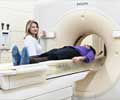Adding CT scans to standard screening procedures may help ER staff determine faster which patients with chest pain are having a heart attack or may soon have a heart attack.

CT angiography is a type of heart X-ray exam using a device that creates pictures of the coronary arteries, allowing physicians to see whether arteries have major blockages.
"Quickly figuring out which emergency room patients have acute coronary syndrome and which patients can go home because they don't have a serious condition is a significant challenge for U.S. hospitals," said Susan B. Shurin, M.D., acting director of the NHLBI. "Identifying the underlying cause of chest pain more quickly with CT scans could allow medical care providers to better allocate limited resources to the patients who are most in need of treatment."
The study results suggest that CT scans allow hospitals to send many patients with chest pain home sooner without compromising their safety. The average length of hospital stay was 23.2 hours for those who underwent CT scans, compared to 30.7 hours for those who underwent standard screening procedures alone. Half of the patients who received a CT scan were discharged in 8.6 hours or less. In contrast, half of the patients in the standard evaluation group were sent home in 26.7 hours or less.
Even with shorter hospital stays in the group that received CT scans, the researchers did not miss any cases of acute coronary syndrome among those participants. After 28 days of follow-up, there was no significant difference in serious cardiovascular events between the two groups.
The study, which appears in the July 26 New England Journal of Medicine, was part of an NHLBI-funded program called Rule Out Myocardial Infarction/Ischemia Using Computer-Assisted Tomography (ROMICAT-II).
Advertisement
The researchers studied 1,000 participants between 40 and 74 years old in nine U.S. hospitals. Participants were eligible to enroll in the trial if they showed symptoms suggestive of acute coronary syndrome but no prior history of heart disease or evidence of heart damage on their electrocardiogram (ECG) tests or blood tests.
Advertisement
Participants in the CT group were exposed to more radiation than those in the standard screening group, though the study authors suggested that future CT scans could be done using less radiation, which could help lower exposure without sacrificing accuracy.
Overall costs were similar in the two treatment groups.
Source-Eurekalert














